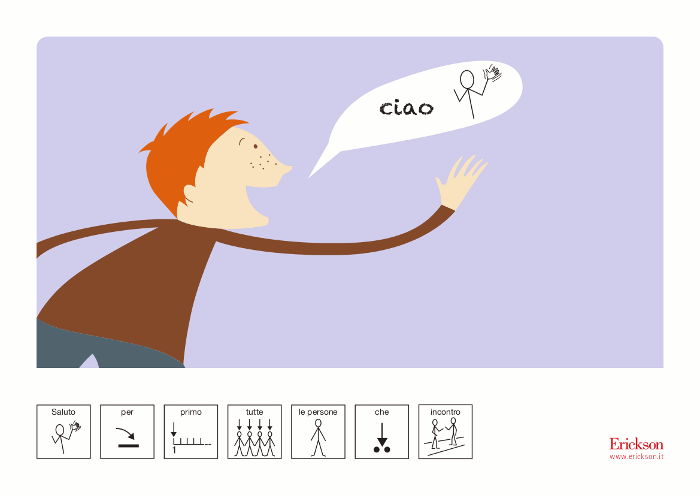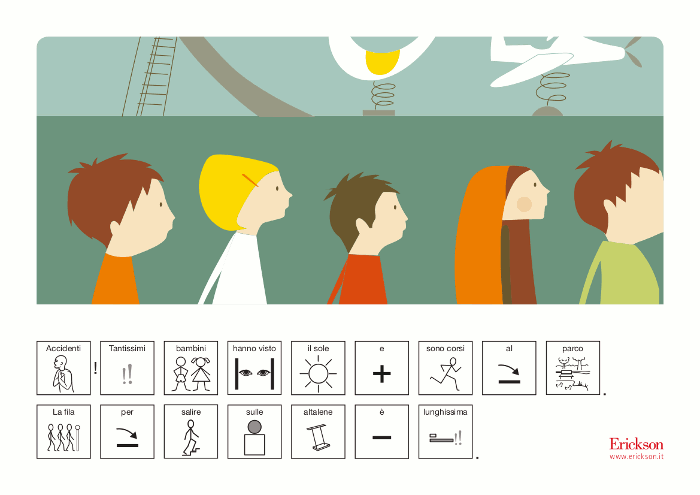 EN
EN
 PT
PT
Three IN-books for children aged 3 – 6: «Paolo and unruly hair», «Anna and the swing», «Luigi and the vegetable soup»
Product: Book
Trim size in cm: 21x10,85
Pages: 3 colourful stories
ISBN: 9788859000013
Publication date: 01/03/2012
Suitable for: Nursery 1st Level (ages 3-4), Nursery 2nd Level (ages 4-5), Primary 1st level (ages 6-7)
REQUEST A SAMPLE OR MORE INFORMATION
Stories with AAC1 is a kit of three IN-books with as many short and simple color illustrated stories for children between 3 and 6. IN-books are illustrated books with text entirely written in symbols. They are meant to be read out loud and are designed for children with complex communication needs. They are the result of the research work in Alternative Augmentative Communication (AAC) carried out with the contribution of parents, teacher and social workers. The quality of the stories, the use of symbols and their function in the course of reading facilitate concentration and attention and greatly improve the understanding of the story. In-books promote linguistic, emotional and cognitive development and their use is not limited to children with special communication needs.
The stories are supported by a Guide to Reading with instructions for parents, teachers and educators on when, where, and how to read IN-books. The book is part of the AAC (Alternative Augmentative Communication) series specializing in this type of communication which replaces/integrates/augments verbal language to compensate for difficulties in verbal expression.
Three IN-books stories:
- Paolo and unruly hair (32 colorful pages)
- Anna and the swing (40 colorful pages)
- Luigi and the vegetable soup (48 colorful pages)

What are in-books?
They are illustrated books with text written entirely in symbols, designed to be listened to whilst another person reads out loud.
How did they come about?
They came about from an Italian experience of Augmentative and Alternative Communication (AAC), with the help of parents, teachers and operators, and they started appearing spontaneously and rather unexpectedly in houses, nursery schools, libraries and many other places. They have since become an important resource for all children, not only those with a communication disability.
How do you read in-books

The most specific element in reading books with symbols out loud is the use of modelling. The person reading constantly moves their finger over the symbols one by one as they read, trying not to let this movement interfere with the liveliness of the story telling. Your finger should be placed beneath the symbol so that both the symbol and the written word, which is placed above so that your finger does not cover it, can be clearly seen. Sometimes, during reading, you can point out details in the picture as well as the symbol, in order to emphasise key moments in the story. It is generally an adult who reads and points at the symbols, whilst the child or children listen.
What do the symbols mean?

Sometimes children want to point to the symbols whilst the adult reads and they enjoy controlling the adult's reading. Some children need to hold the adult's hand during modelling and to feel the movement and rhythm of the reading. The opposite, however, is not recommended - in other words the adult taking the child's hand and moving it passively. Children are never asked to look or point themselves: they are simply «exposed» to the continued pointing, one symbol at a time, in a playful manner. Pointing provides considerable support in capturing the attention of another person and creating shared attention in an environment of common reference. The continued movement of pointing from one symbol to the next accompanies the child's gaze symbol by symbol and facilitates sequence building.
Both transitions are particularly important for children who have difficulties, above all those with praxic and gaze tracking difficulties, like in children with autism spectrum disorders. With the latter, you may initially get the impression that they are not looking or following. If the book is motivating and attracts their attention, you just need to be patient and wait.
The advantages of modelling

In general, children quickly learn how modelling works, they only need to see an adult pointing at the symbols a couple of times before they start doing the same, automatically and naturally imitating what they have seen being done. They thus start to use modelling spontaneously to read IN-books, to themselves or out loud to other children. Through progressive modelling, and without the need for explanations and reminders, they automatically learn the correspondence between the word heard, the symbol and the written word. Reading books with symbols from this viewpoint becomes one of their first «grown-up» activities and children can start to do it on their own, without the constant mediation of an adult. The structure of IN-books enables children to «read» the symbols on their own. Although in the beginning they tend to enjoy the reading out loud and modelling done by an adult they soon learn to appreciate the possibility of enjoying the book on their own. It is not rare to see children who, despite not having developed the function of alphabetic reading, read to each other out loud, pointing at and recognising one by one the symbols in the text, thus supporting their future development of alphabetic reading and writing.
To find out more about AAC and in-books